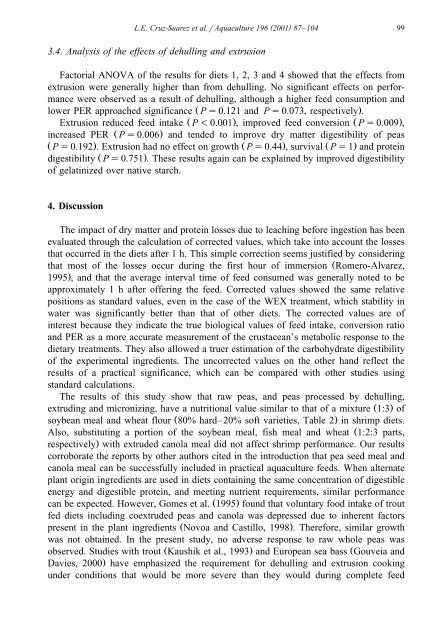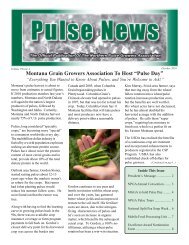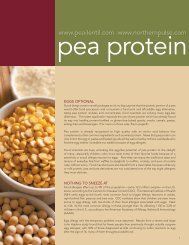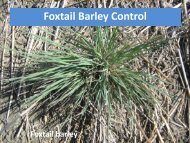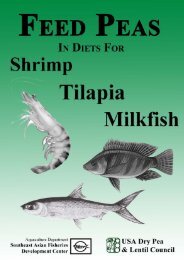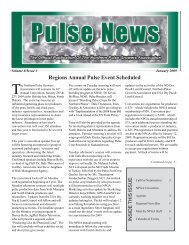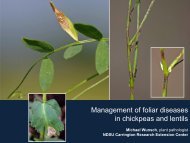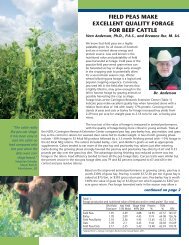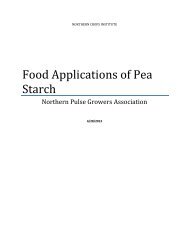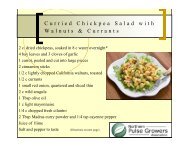Processed feed pea and canola meal for blue shrimp diets
Processed feed pea and canola meal for blue shrimp diets
Processed feed pea and canola meal for blue shrimp diets
Create successful ePaper yourself
Turn your PDF publications into a flip-book with our unique Google optimized e-Paper software.
( )<br />
L.E. Cruz-Suarez et al.rAquaculture 196 2001 87–104 99<br />
3.4. Analysis of the effects of dehulling <strong>and</strong> extrusion<br />
Factorial ANOVA of the results <strong>for</strong> <strong>diets</strong> 1, 2, 3 <strong>and</strong> 4 showed that the effects from<br />
extrusion were generally higher than from dehulling. No significant effects on per<strong>for</strong>mance<br />
were observed as a result of dehulling, although a higher <strong>feed</strong> consumption <strong>and</strong><br />
lower PER approached significance Ž Ps0.121 <strong>and</strong> Ps0.073, respectively ..<br />
Extrusion reduced <strong>feed</strong> intake Ž P-0.001 ., improved <strong>feed</strong> conversion Ž Ps0.009 .,<br />
increased PER Ž Ps0.006.<br />
<strong>and</strong> tended to improve dry matter digestibility of <strong>pea</strong>s<br />
Ž Ps0.192 .. Extrusion had no effect on growth Ž Ps0.44 ., survival Ž Ps1.<br />
<strong>and</strong> protein<br />
digestibility Ž Ps0.751 .. These results again can be explained by improved digestibility<br />
of gelatinized over native starch.<br />
4. Discussion<br />
The impact of dry matter <strong>and</strong> protein losses due to leaching be<strong>for</strong>e ingestion has been<br />
evaluated through the calculation of corrected values, which take into account the losses<br />
that occurred in the <strong>diets</strong> after 1 h. This simple correction seems justified by considering<br />
that most of the losses occur during the first hour of immersion ŽRomero-Alvarez,<br />
1995 ., <strong>and</strong> that the average interval time of <strong>feed</strong> consumed was generally noted to be<br />
approximately 1 h after offering the <strong>feed</strong>. Corrected values showed the same relative<br />
positions as st<strong>and</strong>ard values, even in the case of the WEX treatment, which stability in<br />
water was significantly better than that of other <strong>diets</strong>. The corrected values are of<br />
interest because they indicate the true biological values of <strong>feed</strong> intake, conversion ratio<br />
<strong>and</strong> PER as a more accurate measurement of the crustacean’s metabolic response to the<br />
dietary treatments. They also allowed a truer estimation of the carbohydrate digestibility<br />
of the experimental ingredients. The uncorrected values on the other h<strong>and</strong> reflect the<br />
results of a practical significance, which can be compared with other studies using<br />
st<strong>and</strong>ard calculations.<br />
The results of this study show that raw <strong>pea</strong>s, <strong>and</strong> <strong>pea</strong>s processed by dehulling,<br />
extruding <strong>and</strong> micronizing, have a nutritional value similar to that of a mixture Ž 1:3.<br />
of<br />
soybean <strong>meal</strong> <strong>and</strong> wheat flour Ž 80% hard–20% soft varieties, Table 2.<br />
in <strong>shrimp</strong> <strong>diets</strong>.<br />
Also, substituting a portion of the soybean <strong>meal</strong>, fish <strong>meal</strong> <strong>and</strong> wheat Ž1:2:3 parts,<br />
respectively.<br />
with extruded <strong>canola</strong> <strong>meal</strong> did not affect <strong>shrimp</strong> per<strong>for</strong>mance. Our results<br />
corroborate the reports by other authors cited in the introduction that <strong>pea</strong> seed <strong>meal</strong> <strong>and</strong><br />
<strong>canola</strong> <strong>meal</strong> can be successfully included in practical aquaculture <strong>feed</strong>s. When alternate<br />
plant origin ingredients are used in <strong>diets</strong> containing the same concentration of digestible<br />
energy <strong>and</strong> digestible protein, <strong>and</strong> meeting nutrient requirements, similar per<strong>for</strong>mance<br />
can be expected. However, Gomes et al. Ž 1995.<br />
found that voluntary food intake of trout<br />
fed <strong>diets</strong> including coextruded <strong>pea</strong>s <strong>and</strong> <strong>canola</strong> was depressed due to inherent factors<br />
present in the plant ingredients Ž Novoa <strong>and</strong> Castillo, 1998 .. There<strong>for</strong>e, similar growth<br />
was not obtained. In the present study, no adverse response to raw whole <strong>pea</strong>s was<br />
observed. Studies with trout Ž Kaushik et al., 1993. <strong>and</strong> Euro<strong>pea</strong>n sea bass ŽGouveia <strong>and</strong><br />
Davies, 2000.<br />
have emphasized the requirement <strong>for</strong> dehulling <strong>and</strong> extrusion cooking<br />
under conditions that would be more severe than they would during complete <strong>feed</strong>


